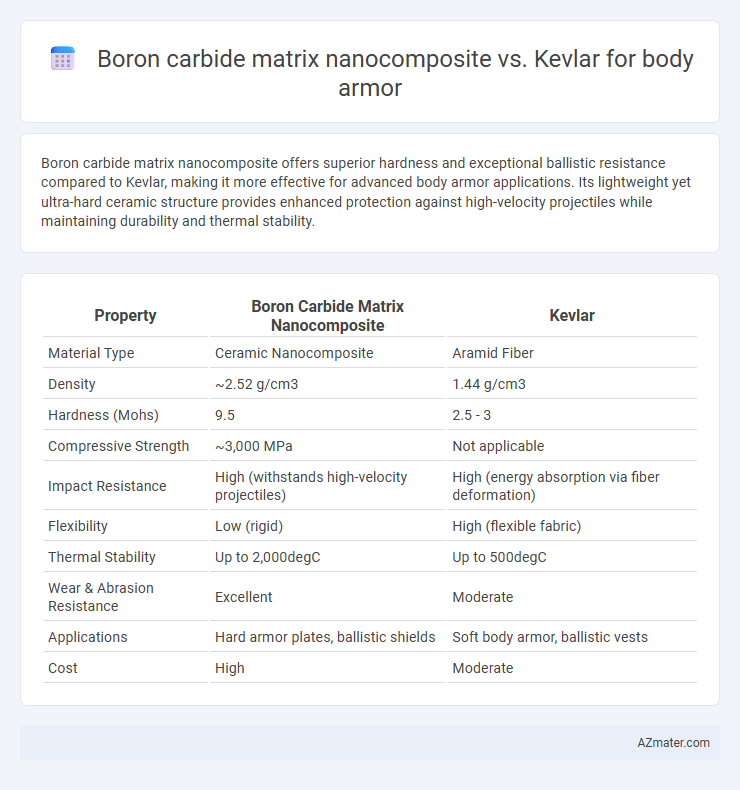Boron carbide matrix nanocomposite offers superior hardness and exceptional ballistic resistance compared to Kevlar, making it more effective for advanced body armor applications. Its lightweight yet ultra-hard ceramic structure provides enhanced protection against high-velocity projectiles while maintaining durability and thermal stability.
Table of Comparison
| Property | Boron Carbide Matrix Nanocomposite | Kevlar |
|---|---|---|
| Material Type | Ceramic Nanocomposite | Aramid Fiber |
| Density | ~2.52 g/cm3 | 1.44 g/cm3 |
| Hardness (Mohs) | 9.5 | 2.5 - 3 |
| Compressive Strength | ~3,000 MPa | Not applicable |
| Impact Resistance | High (withstands high-velocity projectiles) | High (energy absorption via fiber deformation) |
| Flexibility | Low (rigid) | High (flexible fabric) |
| Thermal Stability | Up to 2,000degC | Up to 500degC |
| Wear & Abrasion Resistance | Excellent | Moderate |
| Applications | Hard armor plates, ballistic shields | Soft body armor, ballistic vests |
| Cost | High | Moderate |
Introduction to Advanced Body Armor Materials
Boron carbide matrix nanocomposites exhibit exceptional hardness and low density, providing superior ballistic resistance compared to traditional Kevlar fibers in body armor applications. The integration of nanoscale reinforcements enhances fracture toughness and energy absorption, significantly improving protection against high-velocity impacts. Boron carbide composites offer a lightweight alternative with improved durability, enabling advanced defense solutions for military and law enforcement personnel.
Understanding Boron Carbide Matrix Nanocomposites
Boron carbide matrix nanocomposites exhibit superior hardness and exceptional resistance to ballistic impacts compared to Kevlar, making them ideal for advanced body armor applications. Their nanostructured matrix enhances mechanical strength and fracture toughness while maintaining lightweight properties essential for mobility and comfort. These composites offer improved thermal stability and chemical inertness, outperforming Kevlar in harsh operational environments.
Overview of Kevlar and Its Applications
Kevlar, a para-aramid synthetic fiber, exhibits exceptional tensile strength-to-weight ratio and thermal stability, making it a preferred material for lightweight body armor and ballistic protection. Widely used in military, law enforcement, and personal protection gear, Kevlar enhances resistance against bullets, shrapnel, and stabbing attacks. Its flexibility and high impact absorption capabilities allow for comfortable wear while maintaining critical protection standards.
Comparative Mechanical Properties: Boron Carbide vs. Kevlar
Boron carbide matrix nanocomposites exhibit significantly higher hardness and compressive strength compared to Kevlar, making them more effective at withstanding high-velocity projectile impacts. While Kevlar offers excellent tensile strength and flexibility for lightweight ballistic protection, boron carbide nanocomposites provide superior fracture toughness and abrasion resistance crucial for multi-hit body armor durability. The density difference, with boron carbide being denser yet more brittle than Kevlar, influences the composite's weight and impact energy absorption mechanisms, guiding material selection based on specific protective performance requirements.
Ballistic Performance and Threat Protection Levels
Boron carbide matrix nanocomposites exhibit superior ballistic performance compared to Kevlar due to their exceptional hardness and high compressive strength, enabling effective penetration resistance against high-velocity projectiles. These nanocomposites achieve elevated threat protection levels such as NIJ Level IV, capable of stopping armor-piercing rounds, while Kevlar generally provides protection up to NIJ Level IIIA against handgun threats. The enhanced energy absorption and fracture toughness of boron carbide nanocomposites ensure increased durability and multi-hit capability, making them more suitable for advanced body armor applications demanding high ballistic resistance.
Weight, Flexibility, and Wearability Considerations
Boron carbide matrix nanocomposites offer superior hardness and lightweight properties compared to Kevlar, resulting in body armor that maintains high ballistic protection with reduced weight. Their rigidity limits flexibility, potentially decreasing wearer comfort during extended use, whereas Kevlar provides excellent flexibility and conforms better to body contours. Wearability of Boron carbide armor benefits from advanced composite layering to balance protection and mobility, but Kevlar remains preferred in applications prioritizing ease of movement and prolonged wear.
Durability and Longevity in Field Conditions
Boron carbide matrix nanocomposite exhibits superior durability and longevity in field conditions compared to Kevlar, owing to its exceptional hardness and resistance to wear and impact. This ceramic-based composite maintains structural integrity under extreme temperatures and abrasive environments, significantly outperforming Kevlar's susceptibility to UV degradation and moisture absorption. As a result, boron carbide matrix nanocomposites provide enhanced lifespan and reliable protection in harsh operational settings.
Manufacturing Processes and Scalability
Boron carbide matrix nanocomposites are typically produced using advanced powder metallurgy and hot pressing techniques, which allow for precise control over microstructure but involve high-temperature processing that can limit scalability. Kevlar manufacturing relies on well-established wet spinning and weaving processes, enabling mass production with consistent fiber quality and cost-effectiveness, which enhances scalability for large-scale body armor applications. The complexity and energy intensity of boron carbide nanocomposite fabrication present challenges in scaling up production compared to the more mature and commercially scalable Kevlar fiber manufacturing methods.
Cost Analysis: Boron Carbide Matrix Nanocomposite vs. Kevlar
Boron carbide matrix nanocomposites exhibit higher material and manufacturing costs compared to Kevlar due to the complexity of synthesis and raw material expenses. Kevlar remains more cost-effective for large-scale production and widespread use in body armor, benefiting from established supply chains and fabrication techniques. Despite the initial cost disparity, boron carbide composites offer superior ballistic performance, which may justify investment in specialized applications.
Future Prospects and Innovations in Body Armor Technology
Boron carbide matrix nanocomposites offer superior hardness, low density, and enhanced ballistic resistance compared to Kevlar, making them a promising material for next-generation body armor. Innovations in nanostructuring and hybridization with polymers aim to improve multi-hit performance and flexibility while reducing weight, addressing key limitations of traditional Kevlar composites. Future prospects include integrating smart materials and self-healing technologies to enhance protection, durability, and wearer comfort in military and law enforcement applications.

Infographic: Boron carbide matrix nanocomposite vs Kevlar for Body armor
 azmater.com
azmater.com